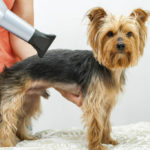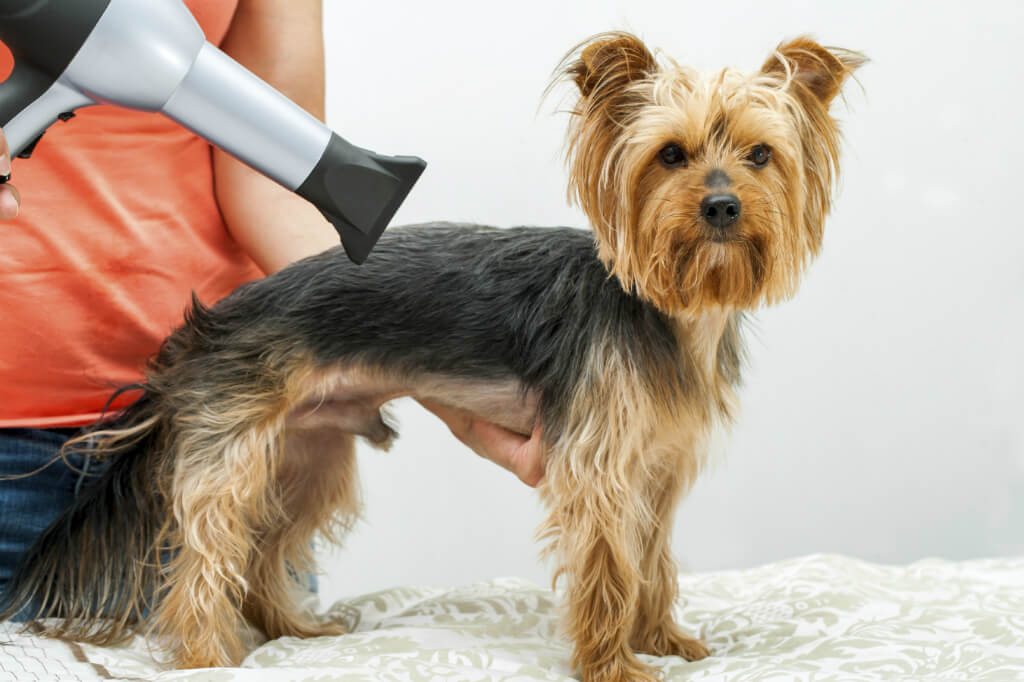Learn here how to groom your Silky Terrier like a pro, in the comfort of your home; brushing the coat, shaping the head, clipping the feet and hocks, suggested tools and equipment to use, and so on…
Pre-Work
- Trim or grind nails every four to six weeks to maintain a healthy foot structure.
- Clean the ears by swabbing with a mild ear cleaning solution. Hair should be plucked from within the ear canal only as necessary for healthy ear management.
- Prior to bathing, quickly go over the entire body and remove any serious mats or tangles. If the tangle can be penetrated with water, leave it and remove when the dog is clean.
- If the dog is in a clipped pet trim and has not been in for professional grooming for six weeks or more, remove the excessive body coat and set the pattern before bathing.
Brushing the Coat
Systemat ically line brush the entire coat, right down to the skin. With a slicker brush, the motion used for line brushing is a “pat and pull.” Softly pat the coat with the full pad of the brush and pull out and away from the skin with each stroke.
ically line brush the entire coat, right down to the skin. With a slicker brush, the motion used for line brushing is a “pat and pull.” Softly pat the coat with the full pad of the brush and pull out and away from the skin with each stroke.
The wrist remains in a neutral, or straight, position. The motion should be light and gentle. Start on the lower rear legs and work upwards towards the thigh. Repeat on every leg then proceed to the body, neck, head, ears and tail.
Work evenly over your Silky Terrier, holding or pushing up the coat with one hand. It can be done with either a comb or a brush, but in most cases the comb is reserved for double checking the work of the brush. With the slicker brush, work the seam line, pulling down a small amount of fur with each stroke.
Do not move to the next section until the brush stroke glides smoothly and the skin at the seam line is seen. Pay close attention to the legs, under the front legs, collar area, ears, and tail.
Let your hands feel for coat density levels. If an area feels heavier or thicker, it will need special attention with a brush or a comb. If static electricity is a problem while brushing, lightly mist the coat with an anti-static product or water while brushing. When finished, each strand of hair should float freely about as the dog moves.
Shaping the Head
The head is left in a natural state with light trimming in the eye area. The Silky Terrier topknot is left free. The entire ear is clipped clean and very close to the skin. Use a #15 blade for the backside of the ears and a #40 with a light touch for the insides.
Edge the ear with small detailing shears, keeping the tips of the shears towards the tips of the ears.
Tail
Slightly neaten the underside of the tail with thinning shears.
Clipping the Feet and Hocks
The feet of Silky Terrier are clean, like a Poodle, but not as close to the skin and a bit higher up on the leg. Clip the top of the foot with a #10 blade with the grain of the coat, or a #7F against the coat growth.
Clip from the wrist to the toes on the front and from the hock to the toes on the rear. Neaten the edges with detailing shears or a #40 when the pads are clipped.
Detail Finish
Lightly neaten the entire outline of the Silky Terrier, removing long, shaggy stray hairs that interrupt a smooth flow. The finished appearance is very natural.
This can be done with thinning shears or shears as long as the look remains natural. Finish with a fine mist of coat polish on the body coat for added shine.
Suggested Tools and Equipment
- Nail Trimmers
- Styptic Powder
- Ear Powder
- Ear Cleaning Solution
- Hemostat
- Cotton Balls
- Clippers
- #40 and #15 Blades for Pads
- Slicker Brush
- Greyhound Comb
- Pin Brush
- Dematting Tools
- Straight Shears
- Curved Shears
- Small Detailing Shears
- Thinning Shears
Breed Facts & Characteristics
Country of Origin: Australia
Height at Shoulder: 9″-10″
Coat Length/Type: Long/Flowing
Color: Shades of blue and tan with the darker color creating a saddle over the back, back of neck and top of head.
Correct grooming procedure: Bathe & Brush Out/Minor Trimming
Common pet grooming practices: Bathe & Brush Out/Clipper-Trim
The Goal: Coat should be mat- and tangle-free. The fur should be light and airy, moving freely with the dog as it moves.

